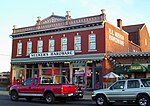Danbury High School is a public high school in Danbury, Connecticut, with approximately 3000 students. It is in Danbury Public Schools. Despite Danbury's population of 86,518 (as of 2020), there is only one public high school, along with several small private schools, and one vocational high school in the city. The school is located in a suburban, residential neighborhood atop a hill that overlooks most of the city.
Danbury High School is the largest high school in the state. Many of the students come from homes in which English is not the dominant spoken language. Therefore, the school offers a wide variety of ESL programs in many different subject areas. Walking through the halls of the school, it is possible to hear over 50 different languages and associated dialects being spoken by the students. Likewise, many of the students will be the first in their family to go on to college. The school's culture and classes are definitely enriched by the diverse student population and the experiences they bring to their education.Danbury High School also offers a large number of AP courses in a wide variety of curricular areas. For example, in the Social Studies Department, AP courses are offered in Human Geography, Government and Politics, European History, Micro and Macro Economics, Psychology, and U.S. History.Danbury High School is supplemented by a magnet program called the Alternative Center for Excellence. This program provides a Danbury High School diploma but exhibits additional criteria not required by most local institutions.In 2013, Danbury High School was awarded $100,000 after winning the State Farm Insurance "Celebrate My Drive" campaign. The "Celebrate My Drive" campaign encourages teens to make positive choices as they start driving.Danbury High School was awarded a total of $40,000 after 2 student's projects won the statewide contest Voice4Change. These projects were to contribute to the water fountains and teacher's faculty lounge furniture at DHS.







